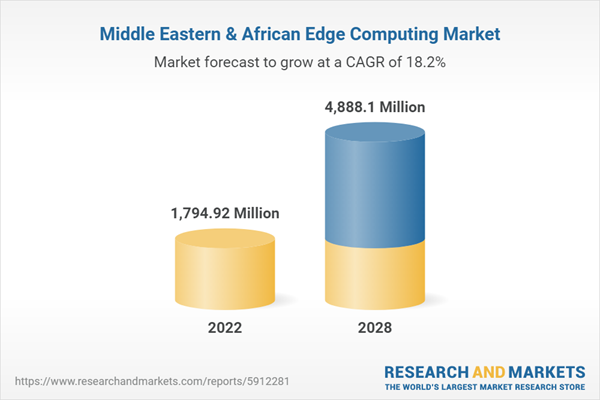Introduction of Autonomous Vehicles and Connected Car Infrastructure Fuels Middle East & Africa Edge Computing Market
The introduction of autonomous cars is on the verge of undergoing extensive research because the autonomous system ensures passenger safety and security. Autonomous vehicles can connect to the edge to improve safety, enhance efficiency, reduce accidents, and decrease traffic congestion. These autonomous cars are equipped with a variety of sensors, and the large amount of data created by these sensors needs to be processed quickly. Machine learning (ML) algorithms used in self-driving cars extract insights from raw data to determine road conditions and make decisions based on them. The growing integration of V2X (Vehicle-To-Everything) technology in the autonomous vehicles would offer potential opportunities for the market growth in the coming years. The automotive vehicles having an interactive advanced driver-assistance system (ADASs) and cooperative intelligent transport systems (C-ITS) are associated as connected cars. The connected-vehicle safety applications are designed to increase situation awareness and mitigate traffic accidents through vehicle-to-vehicle (V2V) and vehicle-to-infrastructure (V2I) communications. The V2X technology accelerates the huge computing demand on autonomous driving edge computing systems. The technology focuses mainly on vehicle-to-vehicle (V2V) and vehicle-to-infrastructure (V2I) goals. The significant increase in deployment of edge computing facilities in road infrastructure, many autonomous driving applications have started leveraging V2X communications to make the in-vehicle edge computing system efficient which is driving the market growth. A few benefits of edge computing in the autonomous vehicles include optimized data, faster 5G response times, infrastructure security, and localized data caching. Thus, edge computing is most widely adopted in these vehicles, which is expected to provide potential opportunity for the market growth during the forecast period.Middle East & Africa Edge Computing Market Overview
Telecom operators in the MEA are focused on strengthening their role in the IoT ecosystem and capturing a larger share of the revenue potential owing to growing demand of IoT platform across various applications. Several telcos have launched platform-focused solutions, including open standard platform as a service (PaaS), cloud, and Big Data and analytics offerings geared toward IoT implementations. For instance, an IoT platform introduced by Ooredoo Qatar enables the development of applications (apps) and management of connected devices for enterprises. It also provides real-time analytics and device security. In May 2019, Ooredoo partnered with EnrichAI to launch new IoT solutions. The estimates published in the latest Nokia MEA Broadband Index Report state that 5G subscriptions are expected to reach 263 million in the MEA by 2026, and the Gulf Cooperation Council (GCC) countries - including Saudi Arabia, the UAE, Qatar, Oman, Kuwait, and Bahrain - would dominate the 5G subscription growth. Thus, the growing implementation of IoT-based solutions and the expansion of 5G subscriptions are the major factors that are anticipated to drive the demand for edge computing solutions in the MEA during the forecast period.Middle East & Africa Edge Computing Market Revenue and Forecast to 2028 (US$ Million)
Middle East & Africa Edge Computing Market Segmentation
The Middle East & Africa edge computing market is segmented into component, applications, enterprise size, verticals, and country.Based on component, the Middle East & Africa edge computing market is segmented into hardware, software, and services. The hardware segment registered the largest Middle East & Africa edge computing market share in 2022.
Based on organization Size, the Middle East & Africa edge computing market is segmented into SMEs and large enterprises. The large enterprises segment held a larger Middle East & Africa edge computing market share in 2022.
Based on application, the Middle East & Africa edge computing market is segmented into smart cities, industrial internet of things (IIOT), remote monitoring, content delivery, augmented reality and virtual reality, and others. The smart cities segment held the largest Middle East & Africa edge computing market share in 2022.
Based on Verticals, the Middle East & Africa edge computing market is segmented into manufacturing, energy and utilities, government, IT and telecom, retail and consumer goods, transportation and logistics, healthcare, and others. The IT and telecom segment held the largest Middle East & Africa edge computing market share in 2022.
Based on country, the Middle East & Africa edge computing market has been categorized into Saudi Arabia, South Africa, the UAE and the Rest of Middle East & Africa. Saudi Arabia dominated the Middle East & Africa edge computing market share in 2022.
ADLINK Technology Inc; Amazon Web Services; Dell Technologies; EdgeConnex Inc.; Hewlett Packard Enterprise Development LP (HPE); IBM Corporation; and Microsoft Corporation are some of the leading companies operating in the Middle East & Africa edge computing market.
Table of Contents
Companies Mentioned
- ADLINK Technology Inc.
- Amazon Web Services
- Dell Technologies
- EdgeConnex Inc.
- Hewlett Packard Enterprise Development LP (HPE)
- IBM Corporation
- Microsoft Corporation
Table Information
| Report Attribute | Details |
|---|---|
| No. of Pages | 150 |
| Published | September 2023 |
| Forecast Period | 2022 - 2028 |
| Estimated Market Value in 2022 | 1794.92 Million |
| Forecasted Market Value by 2028 | 4888.1 Million |
| Compound Annual Growth Rate | 18.2% |
| Regions Covered | Africa, Middle East |
| No. of Companies Mentioned | 7 |









